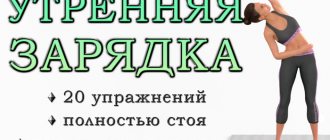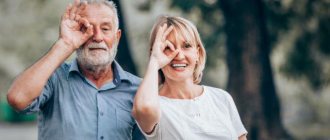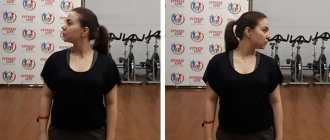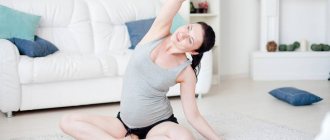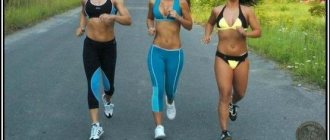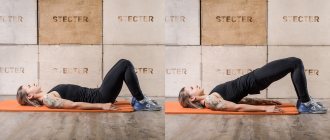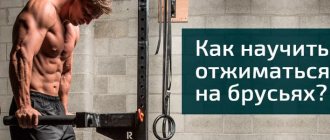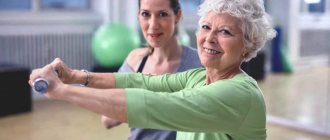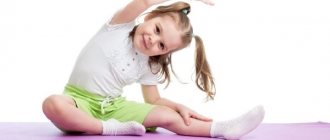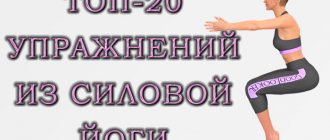After sixty years of age, starting to play sports or change your usual lifestyle is very difficult, and sometimes completely impossible. At this advanced age, a person acquires ailments that he acquired over the years or aggravated those that he had in his arsenal of chronic diseases. One way or another, even in good health at this age, the body noticeably loses ground. First of all, deterioration in health is associated with a decrease in the level of hormone synthesis. The vessels become fragile, along with them the ligaments lose their elasticity, and the fascial tissue becomes rougher, which even leads to pain from movement. To prolong mobility or restore normal functioning of the body at the age of sixty, you need to regularly do exercises aimed at improving blood circulation and mobility of the musculoskeletal system.
Morning exercises for men over sixty
Morning exercises consist of several blocks. The first block is joint gymnastics. It consists of a complex of rotational movements and flexions. It starts with the upper body and ends with warming up the lower extremities.
Neck
- Side turns.
- Side bends.
- Rotation of the head to the sides.
Shoulders and arms
- Rotation of the shoulder joints forward and backward.
- Raising straight arms with clapping overhead.
- Rotation in the elbow joints.
- Rotation in the wrist joints.
Torso
- Body rotations.
- Body rotation.
Small of the back
- Bend forward.
- Side bends.
- Rotation of the pelvis.
Legs
- Alternately lift your legs, bending the knee joint.
- Bend forward without bending your knees.
- Stretching the shins with sagging heels.
Race walking
Sometimes, to recharge yourself with energy and good mood for the whole day, sometimes it’s enough to walk. Race walking for older people bears little resemblance to the Olympic discipline. The speed of a pensioner is much lower and the length of the route varies depending on the condition of the 60-year-old athlete.
And yet, it is walking that increases the speed of blood flow, body temperature and deepens breathing. You can practice walking as part of your daily routine - going to the store or to the market. To the clinic or to the garden to pick up a grandson. Where you used to travel by transport, you can walk. Moreover, walking can be done in any weather, both winter and summer. The main thing is to dress appropriately for the weather and keep your feet dry.
A person walking on foot not only improves his health and saturates his blood with oxygen, but he also relaxes emotionally, enjoying the walk. And as you know, pleasure hormones – endorphins – significantly prolong a person’s life.
Contraindications
Before performing exercises and joint gymnastics, you should make sure that there are no contraindications to the program.
Contraindications include:
- High blood pressure (more than 130/100).
- High pulse, more than 90 beats per minute.
- Headache, nausea, dizziness, shortness of breath.
- Pain in the heart area.
The presence of these unfriendly factors is a contraindication to performing morning exercises after 60. It is also worth reducing the load if you feel unwell during exercise or stop exercising altogether. Excessive exercise may be indicated by tinnitus or rapid heartbeat, stuffy ears, and dizziness.
It is also worth reducing the load or stopping exercise if pain occurs in the muscles or joints. Before adding morning exercise to your daily routine, you should consult your doctor.
Also read: What exercises are best to avoid after 50 years? How to speed up your metabolism to lose weight after 30 → How to increase testosterone for a man after 40?
Positive effects of exercise on the body
Morning and other exercises for people over 60 years of age bring great benefits to the body. Exercise significantly improves general condition, restores tissue and has a positive effect on the functioning of organs, the cardiovascular and respiratory systems, and the musculoskeletal system. The main advantages include the following:
- normalization of the respiratory system;
- strengthening the heart muscle and blood vessels;
- strengthening the immune system, improving the functioning of all organs;
- eliminating the formation of blood clots and preventing other diseases;
- improved posture, positive effect on joints and spine.
With constant training, the result becomes noticeable already in the first weeks of training:
- restoration of movements, ability to perform more physical work;
- metabolism improves;
- weight loss and vigor appear;
- sleep, digestion and the functioning of other systems are normalized;
- muscle atrophy is prevented;
- mental activity becomes clearer, the nervous system comes into tone.
Also, regular physical activity is an excellent prevention of various diseases, including osteoporosis.
What is dementia
With the development of dementia, a person’s mental abilities decrease, existing knowledge and skills are gradually lost, and the ability to learn is lost.
Thinking, orientation, understanding, counting, learning, language and judgment are impaired. There are many reasons why dementia develops. Dementia can be triggered by endocrine and vascular pathologies, depression, certain infections, traumatic brain injuries, brain tumors, alcoholism and drug addiction. Additional risk factors for developing dementia include:
- heredity. Moreover, the risk increases if the pathology in close relatives developed before the age of 65 years;
- obesity;
- lack of active intellectual activity.
Selecting exercises
A gymnastics complex intended for women over the age of 60 must be selected very carefully and carefully. You need to proceed from whether there are any chronic diseases. After all, the main reason why you need to exercise at 60 is to improve your health. Loads must be moderate. At home, it is best to start with:
- breathing exercises;
- warming up the hands and knee joints;
- strengthening the vestibular apparatus;
- walking in place.
These simple exercises may be enough to improve your condition.
Read also
Cholesterol levels in women after 60 - 65 years
One of the most important indicators of health is cholesterol level, which exceeds the norm in women after 60... Read the article >
There are special exercises with dumbbells for older women. They allow you to keep your muscles toned, which in turn will affect good posture, correct gait and improved joint condition. It is important to remember that physical activity must be dosed.
In addition to morning exercises, women over 60 years old are also recommended to do exercises for their facial muscles. They are aimed at training facial expressions and improving blood circulation. Exercises in the video below!
In what situations is charging contraindicated?
Exercise designed for older people has slightly more contraindications, because due to age, the body’s compensatory abilities weaken, and in some cases it cannot cope with the stress. Training should be stopped if:
- Any diseases of an infectious or non-infectious nature in the acute stage;
- Severe intellectual impairment and mental disorders with psycho-emotional agitation;
- Severe disorders of the structure and function of the musculoskeletal system, accompanied by severe pain and significantly limiting the ability to move;
- Malignant neoplasms;
- Detection of aneurysms in the heart and large vessels.
Important!
For people over 70 years old, a set of exercises is selected strictly individually and only after a medical examination. The first classes should be conducted under the supervision of a physical therapy instructor.
On all fours
While in a position on all fours, use the following set of exercises to train the hip joints and all parts of the spinal column:
- raising the leg to the side;
- arching with further straightening of the back;
- moving the leg back;
- stretching your arms forward while simultaneously bending your body and stretching your spine.
The above exercises can improve blood circulation in the tissues of the back, relieve the feeling of fatigue and prevent the development of osteochondrosis. The duration of the training process is 25 minutes.
An elderly person's ideal morning. The doctor tells
“NP”: Please advise what physical exercises should be done in the morning depending on age (40, 60, 80 years)?
SAIKOVSKY:
Physical activity is a rather individual issue. Many people, even at 60, are ready to run a few kilometers and do a climb, and there are those who, at 45, can hardly get out of bed.
But what definitely won’t hurt anyone is a morning workout. Stand up, do a few stretches, bends, and swings of your arms and legs. Regardless of your fitness level, this easy warm-up will help you feel more confident all day long.
If health allows, the warm-up can be supplemented with a short jog.
The main thing is not to overdo it, and don’t rush - make allowances for your age.
“NP”: Tell me, does the morning diet depend on the characteristics of each organism (low/high acidity, blood pressure)?
SAIKOVSKY:
The composition of the morning diet is more a matter of taste rather than medical indications. If there are no specific prohibitions from the doctor, you can choose your morning diet to suit your taste.
The only thing is that it is recommended to reduce sugar consumption as much as possible.
If you can do without sugary foods in the morning, eliminate them from your diet. The older the human body, the more difficult it is for it to eliminate excess sugars.
Excessive consumption of foods like coffee or candy for breakfast can quickly lead to diabetes in older people.
“NP”: What do you think is best for pensioners to drink in the morning (water, coffee, tea, kefir)? Why?
SAIKOVSKY:
Drink water and green tea. These products do not contain sugar and do not affect your nervous system, and tea, especially green tea, can help relieve anxiety and improve mental clarity.
But it is better to replace dairy products with fermented milk, as they are easier to digest and serve as a source of a number of microelements.
“NP”: What time of day do you think you should do exercises? Does the intensity of exercise depend on the age and general physical condition of the body? Is it possible, in your opinion, to move morning exercise to the afternoon?
SAIKOVSKY:
Morning is the best time to exercise. But if you missed your morning exercises, it doesn’t matter - physical exercises can be done at any time, and for older people - even in the evening.
Light gymnastic exercises improve blood flow and help normalize blood pressure. In general, it makes no difference what time of day you do your exercises.
The main thing is to do exercises regularly.
“NP”: Tell me, what physical activities are more useful in the morning for pensioners (physical exercises, water procedures, breathing exercises, Nordic walking)? What loads, in your opinion, are most feasible, taking into account the general physical characteristics of pensioners?
SAIKOVSKY:
Numerous observations have shown that the physical characteristics of the body in people, if they have not previously abused alcohol or drugs, remain unchanged from approximately 23 to 60 years. Therefore, there are no obstacles for you to do exercises on a par with young people.
The most effective technique is to combine warm-up stretching and sprinting. If you can’t run, you can replace running with walking or Nordic walking.
“NP”: Is it necessary to have breakfast in the morning? What is the effect of skipping breakfast or, conversely, overeating?
SAIKOVSKY:
Breakfast is one of the most important meals of the day. For breakfast, it is better to take light types of food - for example, oatmeal with green tea.
The peculiarity here for pensioners is that with age, the body absorbs trans fats and heavy foods less well, including dairy products.
Therefore, the best recommendation in this case is a light breakfast, and leave the main diet for lunch.
It is advisable to exclude dinner altogether - in an elderly body, foods eaten after 7 pm are poorly digested or not digested at all.
“NP”: What do you think should be done in the morning (eat certain foods, do some physical exercise) to feel young, regardless of age?
SAIKOVSKY:
With modern medical capabilities - even after sixty, there are no obstacles for an elderly person to be on an equal footing with young people.
Numerous experiments and studies have shown that the feeling of age is a psychological problem, not a physical one.
Convince yourself mentally that you are 35 years old, even if in reality you are 65. And you will see how much your capabilities and sensations will grow.
Roman Saikovsky, rheumatologist - for “New Pensioner”
Photo: “New pensioner”
Universal gymnastics complex
The universal gymnastics complex includes the following types of exercises:
- circular rotations of the neck;
- swing your arms;
- push-ups from the floor or from the back of a chair;
- squats;
- rotation of the pelvis;
- warming up the hands and ankles;
- lunges forward with the body turning to the sides.
Elderly women who are in good physical shape can supplement the universal gymnastics complex with an exercise with an expander. The average duration of the training process is 35 minutes.
Gymnastics for the elderly
The best time to perform any set of health-improving gymnastics is in the morning. Although you shouldn’t limit yourself to wanting to work out at other times of the day. Regular walking, stretching or stretching of muscles and ligaments is useful throughout the day.
Let us give examples of two sets of exercises, the implementation of which can be combined into one lesson, if there are no contraindications.
Complex 1 (warm-up)
While performing the complex, remember that its implementation should bring only positive emotions. Pain and discomfort cannot be tolerated. If they occur, classes are stopped.
Warm-up goals:
- Stimulate metabolic processes in the body;
- Activate mental and mental health;
- Restore physical activity.
- Sit comfortably in a chair or bed and stretch your legs. Pull your toes towards you and hold them there for 8-10 seconds. Relax your feet. Repeat the exercise in reverse: pull your toes away from you. Hold them like this for 8-10 seconds, then relax your feet. Do it 10 times.
- Without changing the starting position, slowly raise and lower your right arm (up to 10 times). Repeat the movement with your left hand.
- Remaining in the same position, lift your legs one at a time. Try to fix the limb in an elevated position for 2-3 seconds. Each leg must be “held” above the floor at least 10 times.
- To perform this exercise, it is better to lie on the bed. This starting position will serve as a kind of “anti-traumatic” guarantor. Make a "bridge". To do this, lie on your back, lean on your hands and feet and arch your back. Try to make it look like a bridge. If you fall during the exercise, it’s okay: the soft bed will “safeguard” you.
During your workout, pay special attention to your breathing. It should be uniform.
Complex 2 (main)
The workout can be done separately or combined with a warm-up.
- Take any position that is comfortable for you. Breathe evenly, slowly. Lower your head and begin to slowly rotate it clockwise for 1-2 minutes. Then rest for a minute and repeat the rotational movements, but in the other direction. 3-4 approaches will be enough.
- Without changing your starting position, carefully tilt your head towards your right shoulder. Make slow movements. Feel how all the muscles stretch. Try to touch your cheek to your shoulder. Returning to the starting position, repeat the tilt to the left shoulder. Repeat the bends 5-6 times.
- Stand with your hands on your shoulders. With your elbows bent, rotate them first forward (1-2 minutes) and then back.
- While standing, straighten your back with your feet shoulder-width apart. Take a deep breath and lean forward. At the same time as you tilt your arm, move it back. Exhale and return to the starting position. Do 5 to 10 inclines.
- Squats. They need to be performed from a position where the heels are brought together and the toes “look” in different directions. Place your hands on your waist. Don't do deep squats. Do half squats to avoid discomfort. Remember that while squatting, your knees need to be apart. Do 10-12 times.
- With good physical fitness and no contraindications, squats can be made more difficult. To do this, do a deep squat while raising your arms straight above your head. It is enough to complete 4 approaches.
What to pay attention to during training?
Warm up.
An effective pre-workout warm-up will gently prepare the central nervous system, muscles, cardiovascular system and joints for the upcoming load.
Stretching.
High-quality stretching will correct posture, reduce wear on joints and intervertebral discs, and stabilize blood pressure.
Exercise technique.
The correct technique will help not only achieve the desired result faster, but also avoid injury.
Additional weight.
Bone density is no longer the same as when you were 20 years old. Lifting weights will cause more problems than health benefits.
Recovery after training.
Restorative functions deteriorate over the years. Give yourself a little more time for rehabilitation.
What happens if you don't warm up before training?
Pilates at home: a short workout for beginners
Add 60-90 minutes of moderate physical activity to your life every day to stay healthier and more energetic. After all, this way you can spend more time with your loved ones and do what you love for longer.
Exercises for older people
Elderly people starting to engage in physical activity after a long break need to do this carefully and gradually. It is recommended to gradually increase the complexity of the exercises, carefully monitoring the correct technique:
Chair push-ups
To increase stability, it is recommended to place the chair against the wall. Slowly perform 5-10 chair push-ups, trying to feel the muscles of your chest and arms working - while maintaining a conscious tension in your abdominal muscles. Don't twist your neck and make sure your back is straight.
// Push-ups for beginners - technique
Pulling your knees to your chest
First of all, lean your elbows on the chair, stretch your legs and tighten your abs. Then, as you exhale, slowly pull one leg towards your chest - being careful not to arch your back. Switch legs. Perform the exercise for 30 to 60 seconds.
// How to properly pump up your lower abs?
Seated triceps curl
Sitting on a chair, raise your arms bent at the elbows up - then, as you exhale, bring them together. The gaze is directed ahead. Perform 3-4 cycles of 12-15 repetitions of the exercise in each, 30-40 seconds break at the end of each cycle.
// Exercises to strengthen your arms
Arm raises with dumbbells
This exercise strengthens both the arm muscles (primarily the biceps) and the muscles of the shoulder girdle. Sitting straight, arms with light weights along the body - either small dumbbells or a 500 ml bottle of water will do. Raise your arms up, then lower them. Perform 3-4 cycles of 12-15 repetitions.
Triceps push-ups
A more difficult exercise to strengthen the triceps (the muscles in the back of the arms) is reverse chair push-ups. Place your hands behind your back, position them on a chair, then (engaging your triceps) lift your torso and place your body weight on the chair—keeping your legs extended. Perform 12-15 repetitions.
// How to properly train triceps?
Seated leg pull-ups
Advanced abdominal exercise. Sitting on a chair, first raise your legs bent at the knees 10-15 cm up, ensuring that the abdominal muscles are involved in the work - then, as you exhale, stretch your legs forward. Stay in this position for 10-30 seconds, repeat 1-3 times.
// What are the benefits of static exercises?
Lying pelvic raises
This exercise is suitable for strengthening the lower back and lower back - however, it has a number of contraindications. Raise your legs up, place them on a chair, then lift your pelvis up, stretching your spine in one line. Hold for 10-30 seconds, then break for 30-40 seconds. Complete 1-3 cycles in total.
// Exercises for straightening the spine
Stepping onto a chair
An advanced exercise to strengthen the muscles of the legs - especially the muscles of the thighs and buttocks. Standing straight (for an added challenge, grab weights in your hands), step onto a chair, then come back down and switch legs. Perform 5-10 repetitions for each leg, for a total of 3-4 cycles.
Lunges with a chair
One of the most effective home exercises for strengthening the buttocks. Take your leg back and place it on a chair - then do squats with the other leg, keeping your abs tense. Perform 10-12 repetitions for each leg, for a total of 3-4 cycles.
// How to pump up your buttocks at home?
A few more tips
1.If you are right-handed, from time to time perform your usual rituals with your left hand. And vice versa. For example, use your other hand to brush your teeth or use this technique during breakfast or lunch.
2.Another useful exercise is to take a shower or perform other normal activities with your eyes closed.
3. When getting to work, the store and other places, change your route regularly.
4. Try watching films without sound from time to time, and try to understand what is being said by the actors’ gestures and movements.
Lying on your stomach, side, back
Lying on your stomach, side or back, you can perform the following set of beneficial physical activities:
- scissors;
- simultaneous lifting of legs and arms;
- swimming;
- pumping to the sides, which provide massage to all parts of the spine;
- moving the leg back or to the side;
- arching your back while lying on your stomach.
The above exercises must be performed as carefully and slowly as possible so as not to injure the spine and prevent sprains. The average training duration is 20 minutes.
